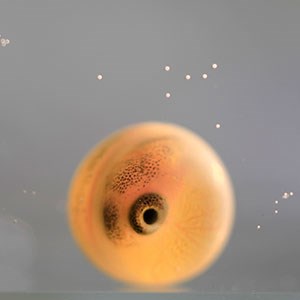The project will identify the main causes affecting male fertility and assess to which degree they explain the low reproductive performance in Arctic charr farmed in Sweden. Multiple parameters will be explored, such as age, sampling time during the spawning season, and genetics. Finally, we will analyze the possible effect of male reproductive dysfunctions on progeny using RNA sequencing.
Background and objectives
The aquaculture industry in Sweden is currently witnessing a significant push for upscaling the supply of fish products on the market. Arctic charr is a key species in this context: it is the second most farmed fish in Sweden and the target of a national breeding program since 1980. Fertility is the key to success for the sustainability and economics of the fish farming industry.
Issues related to fertility were reported in Arctic charr breeding stock at Vattenbrukscentrum Norr. Aquaculture results in lower sperm quality in Arctic charr males, reducing the number of fertilized eggs and hatched embryos. However, the factors that affect sperm qualities remain to be investigated.
The main objectives of the current project are described below:
- Uncovering the effects of age and spawning time
Limited information is available on how male fertility changes across their reproductive life or in response to sampling time during the spawning season. At the same time, infertile males kept in a breeding stock may cause serious issues and even egg loss at the hatchery. In the current project, we will reveal which breeding males retain high fertility across the whole reproductive season and how fertility varies across the reproductive age.
- Revealing the genome-wide regions associated with male fertility
One of the major challenges in fish genomics is understanding the genetic basis of reproductive traits. Genetic markers, such as SNPs, and genome-wide association studies (GWAS) are practical and reliable tools for discovering genomic regions affecting male fertility. The availability of whole-genome sequence data greatly facilitates the identification of high-impact SNPs or genomic regions contributing to fertility. We will employ large-scale GWAS using a cost-effective, low-coverage whole genome sequencing technique to provide new candidate genome regions associated with male fertility in Arctic charr.
- Determining the effect of the sperm transcriptome profile on progeny
New evidence indicates that sperm cells carry a range of RNA types, with distinct profiles observed between fertile and infertile males. Several studies have also revealed the crucial role of sperm RNAs in spermatozoa formation, fertilization, and early embryonic development. We will apply RNA sequencing of sperm and the respective offspring to capture all possible effects of RNAs on sperm function, male fertility, and their progeny at early development stages.
Main applicant: Khrystyna Kurta, Postdoctor at the Department of Animal Breeding and Genetics, Faculty of Veterinary Medicine and Animal Science, Quantitative Genetics.
Partners involved:
